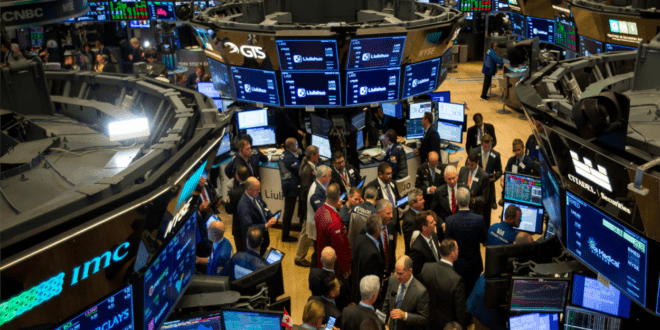As the market closed last Friday (June 19, 2020), the S&P 500 was going up to 41% from the March 23 lows.
According to FactSet, the rally in stock process combined with the reduction in earnings forecasts have pushed the S&P’s forward 12 months P/E ratio to 21.9. The widely used valuation metric is now way up to its 10-year coverage of 15.2 and a 5-year average of 16.9.
Although this might seem daunting, top strategists of Wall Streets offer comprehensive explanations as to why it is happening. They also advise that risks facing the equity investors appear to tilt downward.
- Recent economic data were strong.
Key metrics such as the payrolls and retail sales grew more than any economist could expect last month. AS such, it suggests that the economy is in better shape than what was previously thought, at least in the short term.
According to Steve Wieting of Citi Private Bank, the reopening of economies brought about economic activities from the quickest pace of measured decrease to the fastest degree of increase in history.
In regards to retail sales, Jonathan Golub of Credit Suisse said that we learned how difficult it is to spend a lot of money when you cannot even leave your home. As proof, there was a $9k decrease in personal expenditures on a yearly basis. This results in an increase in personal savings ranging from $4.2k – $18.6k. Although some portion of this saving will be banked, post-quarantined consumers seem to be ready to start reopening their wallets.
- Ps leading Es
With the early phase of the market selloff, earnings [E] revisions will lag stock prices [P]. While the P/E ratios seemed to be dropping now, it was for no other reason than the E not having yet been revised lesser as analysts had not yet adjusted to the recessionary economic environment.
However, the opposite might be happening right now. Strategists from Wall Street are now creating and modeling in the revised estimates coming from colleagues in the department of economic research. Thus, surging Ps also means surging P/Es.
Francois Trahan of UBS said that this kind of behavior between EPS and P/Es is also a typical around cycle bottoms. The P/Es usually recover first then earning shortly follow suit. This is a signal that recovery is sustainable and that equities have a much better future ahead.
- Low rates
Low-interest rates seem to justify the higher stock market valuations.
Golub said that the Stock multiples have dramatically increased over the past year from a 16.5x – 21.7x of today. Meanwhile, the 10-year Treasury yields and the investment-grade corporate bond yields have dropped from the 2.1 percent to 0/7 percent and 4.5 percent to 3.6 percent.
Unsurprisingly, many investors are making that the current, elevated stock valuations are still justified due to the collapse in rates.
- Big tech skewing
The broad market indices such as the S&P 500 have been led and controlled by the eye-popping increase in massive tech stocks such as Amazon, Apple, Microsoft, and Netflix, which are up 20 percent – 40 percent year to date. Also, the Nasdaq is up to 10 percent this 2020, while Dow and S&P are in the reds.
This resilience of the tech industry can be seen in the comparative outperformance of the Nasdaq Composite Index in the year to date (some 40 percent tech and tech-related stocks). In general, tech stocks come with better earnings growth, thus comes the higher P/Es.
- E will surge according to history
History suggests that E will have a surge with corporate profits have almost always experience V-shaped recoveries.
Wildcards Beware
The market appears to have pricing good news and the prospect if on its way to recovery. That, however, has its own risk as there continues to be a lot of some serious unanswered questions.
In that note, John Normand of JPMorgan identified 6 wildcards which look like some potential spoilers:
- A second wave of the COVID-19 cases
- The end of monetary stimulus
- Temporary fiscal stimulus measures expiration
- US election outcome which leads to corporate tax increase
- The US sanctions on China “post-November on Trump’s re-election or the Pre-November to boost the rating of Trump”
- Hard Brexit
So, while it is certainly possible to argue that the current stock market is not that overvalued, there are considerable downside risks.
The potential valuation problem is even more relevant to the wildcard’s roles, perhaps since market momentum has been strong in recent months, then the sources of downside risks in H2 are higher than the sources of upsides.
Howard Marks, a billionaire investor, agrees to this. He said that the potential for further gains is better than expected or the valuations expanding, even more, does not fully compensate the risk of decline from multiples contracting or events disappointing.
In simpler terms, this fundamental outlook seems to be positive on balance, however, with the listed security prices, the odds are not in the favor of the investors.


While Wall Street started as a street in lower Manhattan in the last century, today the term has come to mean more. Now it refers to the businesses directly related to stock exchanges and the financial markets, and even more broadly, big business and investing in the United States.
Great items from you, man. I’ve be mindful your stuff prior to and you’re simply too excellent. I really like what you’ve obtained right here, really like what you’re saying and the way through which you assert it. You make it enjoyable and you still care for to stay it sensible. I can not wait to read far more from you. That is really a great web site.